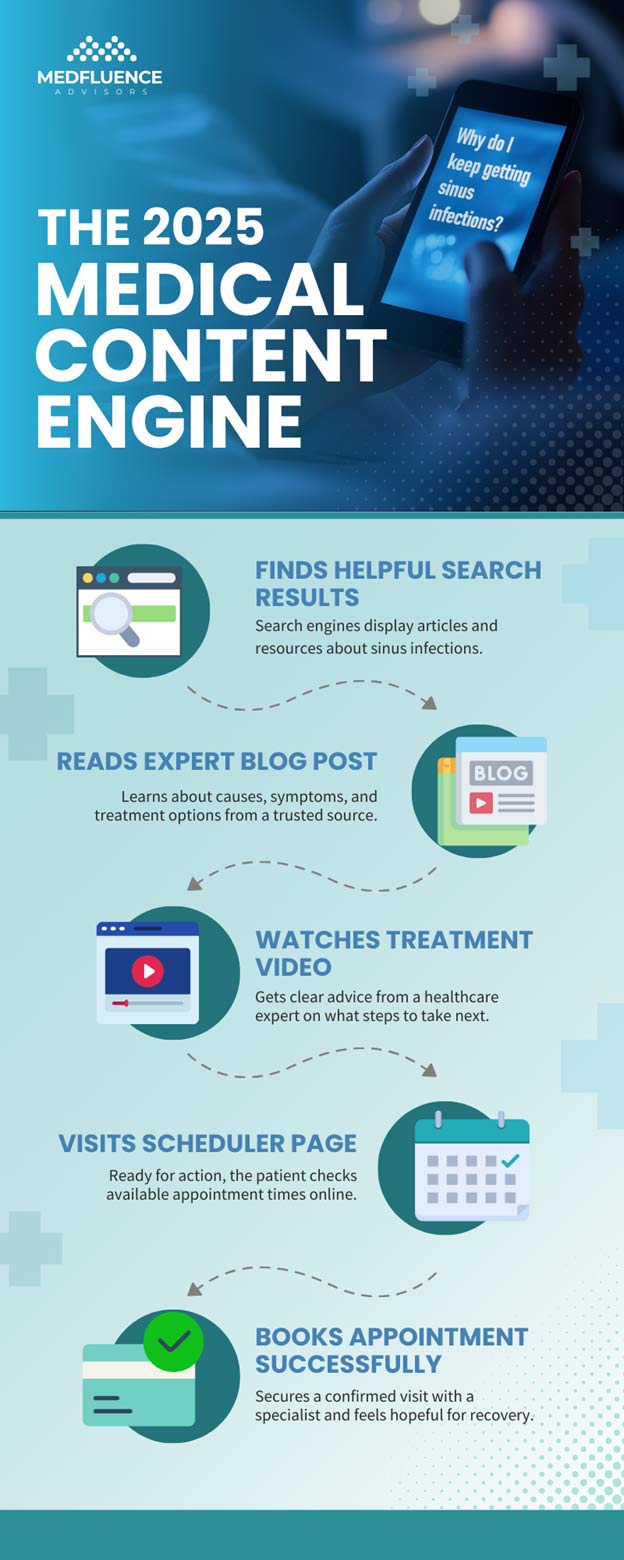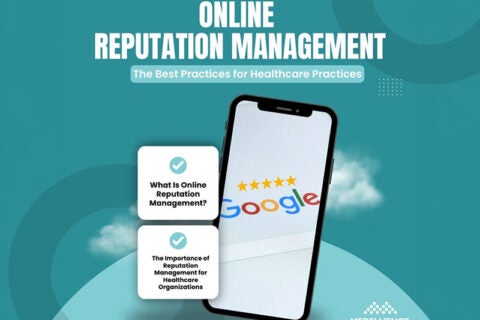How to Leverage Content Marketing for Medical Practices in 2025

The gap between innovative medical solutions and patients who need them most has never been more bridgeable than in 2025, where content marketing serves as the crucial connector. Today’s patients begin their healthcare journeys online, researching symptoms and treatment options before ever setting foot in a medical office. For small to mid-sized practices specializing in advanced treatments for complex conditions, thoughtful content strategy isn’t just about visibility—it’s about reaching those specific patients who have been searching, sometimes for years, for exactly the solutions you provide.
1. Know Who You’re Talking To (And What They’re Googling at 2 AM)
Most practices still build content around surface-level demographics: age, gender, location. That’s not enough. A 47-year-old woman in Baton Rouge could be looking for anything from sinus relief to spinal decompression to hormone therapy. What matters more than who she is on paper is what problem she’s trying to solve when she picks up her phone in the middle of the night.
Focus on Pain Points, Not Personas
Instead of saying “Our patient is a middle-aged male with back pain,” say this: “Our patient is waking up three times a night because the shooting pain in his leg won’t let him sleep—and he’s exhausted by the runaround he’s gotten from other providers.”
This kind of thinking shifts the tone and focus of your content. It forces you to write answers to real questions people are typing into Google, like:
- Why does my leg go numb when I sit too long?
- Can nerve pain go away on its own?
- Is sciatica permanent or fixable?
These are entry points—what we call “moment-of-pain searches.” If your content appears here, you’ve already won half the battle.
Use Real Patient Data (Not Fluff)
Forget vague buyer personas and start looking at actual intake forms, call logs, and patient reviews. What terms are they using? What conditions do they mention most often? What’s the average delay between symptom onset and seeking treatment?
One example: Internal data from practices using our platform showed that over 70% of sinus patients had Googled their symptoms at least five times before booking. The majority weren’t searching “chronic sinusitis”—they were typing things like:
- Why do I keep getting sinus infections every month?
- Sinus headaches or migraines?
- How to drain sinuses without surgery
These are the exact phrases that should shape your blog titles, video scripts, and even page headers. You don’t need to guess. The data’s already in your office.
The Rise of Long-Tail and Voice Search
Short keywords like “back pain treatment” are saturated and vague. Long-tail queries—“is it normal to have back pain a year after a car accident”—are where the real conversions come from. They’re specific, high-intent, and often phrased as full questions.
And in 2025, voice search is only growing. Nearly 58% of U.S. adults used voice search weekly last year, and that number is trending up. Voice searches are conversational and context-driven, meaning your content needs to match that tone.
Example: Instead of titling a blog “Sinus Treatment Options,” try “What’s the fastest way to stop a sinus infection without antibiotics?”
Stop Writing for Everyone—Write for the Patient You Want
If your content is trying to attract everyone, it ends up resonating with no one. Broad, generic blog posts like “What Is Back Pain?” or “Do I Have Allergies?” are a waste of time unless you’re planning to outspend leading websites on ad dollars.
Tailor Your Content for High-Intent, Pre-Qualified Leads
You don’t need more traffic—you need better traffic. Focus on attracting people who are close to booking, not just browsing. These are the folks searching:
- Best ENT near me for nasal polyps removal
- Minimally invasive spinal surgery reviews in X City
- Can balloon sinuplasty be done twice?
This is content that filters in people who already suspect they need your service. And it quietly filters out the rest. That’s a good thing.
Make Peace With “Niche”
Trying to appeal to every possible patient makes your practice forgettable. But if you get known as the practice that helps people finally breathe after years of sinus misery—now you’ve got something.
Your “niche” isn’t limiting—it’s defining. Pick a focus and go deep. That’s how you dominate search and build trust.
Real-World Topic Clusters That Convert
Topic clusters help Google understand what your site is about—and help patients binge your content like a Netflix series.
Example: If you’re targeting sinus patients, you can try using this cluster:
- Core Page: Chronic Sinusitis Treatment Options
- Supporting Blogs:
- Why Your Sinus Infections Keep Coming Back
- Balloon Sinuplasty vs. Traditional Surgery: What to Know
- Can Sinus Issues Cause Fatigue and Brain Fog?
- How Long Is Recovery After Balloon Sinuplasty?
These clusters keep readers moving through your site—and nudge them toward a consultation.

Use SEO, But Don’t Let It Use You
SEO is still essential, but it’s evolved. If you’re still stuffing keywords like it’s 2010, you’re already invisible. Today, Google’s smarter, even better—and this means your content has to be too.
Search Algorithms Have Changed—So Should Your Strategy
Google now rewards experience, expertise, authoritativeness, and trustworthiness (E-E-A-T). With Google’s evolving algorithm, that means::
- Vague, AI-spun content= punished
- Firsthand knowledge and medically sound info = rewarded
- Pages written like real conversations = gold
If you’re writing to check a box, don’t bother. If you’re writing to answer the exact question someone’s desperate to solve, now we’re getting somewhere.
What Actually Moves the Needle (Hint: It’s Not Just Keywords)
With the new algorithm updates, the following strategies work in 2025:
- Clear, helpful content that actually answers the question
- Internal linking to keep readers on your site
- Topical authority built through smart clusters (see section above)
- Fast site speed and mobile-first design (Google’s not messing around here)
- Patient-first language over robotic SEO gibberish
Also: short paragraphs, bullets, and subheadings. Nobody wants to read a wall of text. Make it skimmable or lose the reader.
On-Page SEO Mistakes Most Practices Still Make
Let’s fix the usual suspects:
- Title tags that don’t match what the page actually says
- Meta descriptions that are either missing or sound like they were written by a bored intern
- H1s that are too clever for their own good (“Breathe Easy Today” means nothing to a search engine)
- Missing schema markup, which helps Google understand what your page is and who it’s for
If your website is more confusing than helpful, Google will treat it like clutter—and so will patients.
Video, Audio, and Other Non-Written Content You Should Actually Care About
We get it. Everyone’s telling you to hop on TikTok or start a podcast. But most practices don’t need to chase trends—they need content that builds trust and helps patients say, “Yeah, this is the doctor I want to see.”
Why TikTok Isn’t the Answer—But Short-Form Can Work in Healthcare
TikTok can be great for viral dance trends or skincare hacks, but for medical practices? It’s usually a time sink. Some researchers even consider it dangerous due to high chances of misinformation. Instead, short-form content that lives on your own site or YouTube channel makes way more sense. Try short-form content like:
- 60-second clips answering a common patient question
- A 2-minute explainer of what to expect during a procedure
- A quick walk-through of your office so it feels familiar before a visit
This isn’t about building a massive following—it’s about building confidence in the right patient at the right moment.
Low-Budget Ways to Create Video Q&As, Walkthroughs, and Patient Stories
You don’t need a film crew. A quiet room, decent lighting, and your phone’s camera are enough. Focus on:
- Doctor Q&As: Record yourself answering the top 10 questions your front desk hears every week.
- Patient walkthroughs: Show what happens from check-in to post-op. Comfort reduces no-shows.
- Success stories: A 30-second clip of a real patient saying, “I finally got my life back” goes farther than any copywriter can.
Don’t overproduce—patients trust real over polished. If it looks like it was filmed on a lunch break, that’s fine—as long as it’s honest and clear.
How to Repurpose One Good Idea into Five Content Formats
Let’s say you write a blog titled: “Is Balloon Sinuplasty Worth It?”. Here’s how to make that one idea work five times as hard:
- Blog post: these should be written for search
- 60-second video: doctor gives the bottom line
- Infographic: pros/cons comparison
- Email: break down the blog into a quick, scannable message
- Social caption: pull the juiciest stat and ask your audience a question
Good content is reusable. Great content multiplies itself.
Your Website Is a Sales Rep, Not a Brochure
Most practice websites still think they’re billboards or business cards. They’re not. They’re sales reps—and many of them are really bad at the job.
Make Your Homepage Speak to Frustrated, Overwhelmed Patients
Most visitors to your homepage aren’t “just browsing.” They’re tired of not feeling heard. They’re wondering if they’ll ever find a solution that actually works.
So ditch the fluffy copy and say something real. Like:
- “Still not getting answers about your sinus symptoms? We see this every day—and we help people find real relief.”
- “We treat patients who’ve tried everything else. If that’s you, you’re in the right place.”
That’s how you grab attention—and earn trust in under five seconds.
Where Most Practice Websites Lose Potential Leads
If you’ve been browsing healthcare content online, these are some of the things that you might notice that typically kills conversion:
- Cluttered pages with no clear direction
- Bland calls to action (“Contact us today” doesn’t move anyone)
- Stock photos that scream “generic healthcare”
- No proof that you actually help people (testimonials, before-and-afters, case studies)
Patients don’t want to work hard to figure out what you do. If they have to scroll or guess, they’ll leave.
Content Elements That Guide Patients to Take the Next Step
Based on research and our personal experience, here’s what you can do to your content to take it to the next level:
- Clear, emotionally honest headers (“Still waking up congested every night?”)
- Calls to action that feel natural (“Let’s talk about what hasn’t worked—so we can try something new.”)
- Real photos of your team and clinic
- Trust signals like Google reviews, media mentions, or number of procedures performed
- Simple forms with minimal friction
Bottom line: every piece of your website should move a visitor one click closer to care. If it’s not doing that, it’s just taking up space.
The Follow-Up Funnel: What Happens After Someone Reads Your Stuff
Content without follow-up is a dead end. Once someone reads your blog or downloads your guide, you need a system that moves them forward without feeling like spam. Offer something valuable—a quiz, a checklist, a patient story—and capture their email with minimal friction. Then, send a short series of human-sounding emails that address real concerns, share success stories, and make it crystal clear how to take the next step. Every click should lead to either your scheduler or a call—anything less is wasted effort.
Measuring What Actually Matters (Spoiler: It’s Not Traffic)
Traffic’s a feel-good stat. It tells you how many people showed up—not how many took action. If you’re not measuring outcomes, you’re just watching the scoreboard while losing the game.
The Difference Between Vanity Metrics and Valuable Leads
Pageviews and social shares might look good in a marketing report, but they don’t necessarily reflect progress toward your actual business goals. Instead of focusing on how many people visited your blog, start tracking how many downloaded your lead magnet, clicked through to your scheduling page, or called your office after reading an article.
Those are the metrics that matter—concrete actions tied to real patient interest. They tell you whether your content is doing what it’s supposed to do: move people one step closer to choosing your practice for care.
How to Track Real ROI From Your Content
To truly understand which pieces of content are driving results, you need to set up proper tracking systems. This starts with using UTM parameters on links in your emails and social posts so you can see exactly where conversions are coming from. Make sure your website analytics are configured to track goal completions—like form submissions and scheduler clicks—not just traffic.
If you’re using a CRM or scheduling platform, connect it with your content tools so you can follow the patient journey from first click to booked consultation. When a single blog post leads to a $7,000 procedure, you need to be able to trace that line. Otherwise, you’re just guessing.
When to Pivot—and When to Double Down
Not every content idea is going to perform well, and that’s okay. What matters is that you’re paying attention to the signals that tell you when to make adjustments. If a blog post is getting traffic but no conversions, revisit the call to action or rework the messaging to better reflect what your ideal patient actually cares about. If one lead magnet is driving the majority of your qualified leads, consider creating more content around that same topic or pain point.
Likewise, if your email open rates are low or engagement is falling off, test different subject lines, storytelling approaches, or content formats. But when something works—when you find a message that resonates or a format that drives consistent leads—don’t move on too quickly. Repurpose it. Promote it through different channels. Turn it into a full content cluster. Momentum compounds when you build on proven wins instead of constantly chasing new ideas.
Content as the Bridge Between Patient Needs and Medical Solutions
Effective medical content marketing transcends traditional advertising by addressing patients’ deepest questions while showcasing physicians’ unique approaches to care. When practices share valuable insights about conditions and treatments, they’re not just generating leads—they’re building trust with patients who need specialized help.
Medfluence recognizes this connection between educational content and practice growth, helping physicians develop resources that serve as bridges between suffering patients and life-changing care. Healthcare continues to evolve, the practices that thoughtfully document and share their expertise will find themselves naturally attracting the patients they’re most equipped to help. The most powerful marketing doesn’t feel like marketing at all—it feels like assistance, guidance, and ultimately, hope.


